Speech The Committed Liquidity Facility

Christopher Kent[*]
Assistant Governor (Financial Markets)
Address to Bloomberg
Sydney –
- Audio 18.96MB
- Q&A Transcript
- Download 310KB
I'd like to thank Bloomberg for the opportunity to speak to you about the committed liquidity facility (CLF). The CLF has been in place now for almost five years.
As we announced in June, after a careful review, the RBA will be adjusting the settings of the CLF starting from next year.[1] Today, I thought it would be helpful to discuss the developments that have led us to make these adjustments. We have also published a detailed article on this on the RBA's website.[2] But first, let's review why we needed the CLF in the first place.
Why Do We Need a CLF?
The global financial crisis highlighted how important it is for banks to manage their liquidity risk. During the crisis, many banks overseas faced significant liquidity problems having not paid enough attention to their liquidity management in the lead up to the crisis.
Following this experience, the Basel Committee on Banking Supervision proposed tougher liquidity requirements as part of its broader package of reforms, known as the Basel III regulations. These changes have made the banking system more resilient to periods of financial market stress.
One of the key planks of the requirement to increase liquidity of the banks was the introduction of the liquidity coverage ratio (LCR). The LCR requires banks to have enough high-quality liquid assets (HQLA) to cover their estimated net cash outflows during a scenario that entails a 30-day period of stress. The idea is that a bank experiencing stress will have enough liquid assets that they can use to meet their short-term liquidity needs. In this way, each bank holds a sufficient amount of HQLA as self-insurance against liquidity risk. Like all insurance, this comes at a cost. In this case, the cost to each bank is incurred because the HQLA earn a lower yield than alternative, less liquid assets that the bank could otherwise hold, such as mortgages or business loans.
For HQLA securities to be of sufficient quality and liquidity, they should be both low risk and actively traded in markets. In Australia's case, Australian Government Securities (AGS) and securities issued by the state and territory borrowing authorities (semis) meet this test. In contrast, there is relatively little trading in other Australian dollar securities, such as those issued by foreign agencies (supras), banks and securitisation trusts (Graph 1).
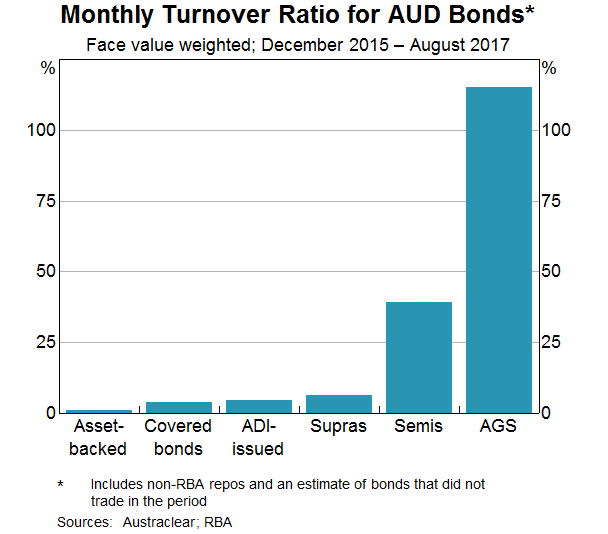
However, there is less government debt in Australia relative to the size of the banking system, and the economy more generally, than is the case in many other countries (Graph 2). This means that there are fewer HQLA in Australia. Indeed, back in 2015, if there had been no other way for Australian banks to meet their LCR, collectively they would have had to have held around two-thirds of the total stock of AGS and semis. And if the banks had held such a high share of those government securities, the liquidity of those markets would have been substantially impaired, thereby defeating the purpose of them being counted on as HQLA.
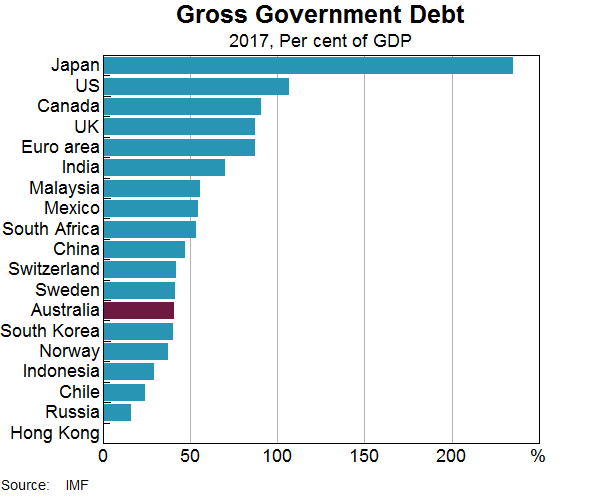
In recognition of this issue, the Basel liquidity standards allow jurisdictions with limited HQLA to use alternative approaches. One of those approaches is for the central bank to offer a facility to provide banks with a guaranteed source of liquidity.[3] And so the CLF was born. This entails the central bank committing to stand ready to provide a bank with liquidity against high-quality collateral that would otherwise be illiquid in the market. This commitment can be counted by banks towards meeting their LCR. In return for the CLF, banks are charged a fee on the entire committed amount, whether or not it is actually drawn upon. This fee is akin to the insurance premium that banks would implicitly pay if instead of the CLF, they had to hold additional HQLA.
Starting from 2015, the RBA has provided the CLF as part of Australia's implementation of the Basel III liquidity reforms.[4]
The First Five Years of the CLF
Under the CLF, the RBA commits to provide liquidity under repo against securities eligible in its operations. To access the CLF, a bank must meet several conditions: it must have paid its CLF fee; the bank's CEO has to have attested that the bank has positive net worth; and the RBA has to have judged that this is indeed the case.[5]
In the five years since the CLF was introduced, 15 banks have applied to APRA for access to the CLF. None of these banks have needed to draw on the facility in response to a period of financial stress.
Each year, APRA determines the total size of the CLF. It's the difference between the banking system's liquidity needs and the amount of AGS and semis that the RBA assesses that the banks can hold without impairing the functioning of the market. The size of the CLF was set at $274 billion in 2015. As an input to this, the RBA assessed that the banks could reasonably hold 25 per cent of the stock of AGS and semis. This was a sizeable step up from their holdings earlier in the decade (Graph 3).
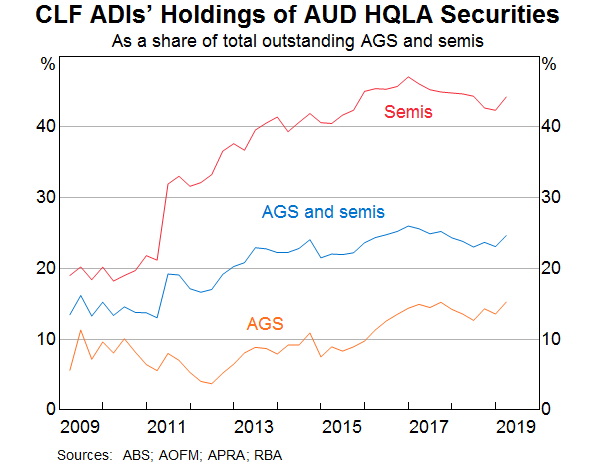
However, since then, the stock of AGS and semis has increased by almost a third. In comparison, the LCR requirements of the banks have been little changed. So the banks can hold more HQLA securities compared to their liquidity needs. As a result, the size of the CLF has declined to just below $250 billion. The increase in AGS and semis also means that the shortage of HQLA securities is not as large as it once was, although there is still a shortage.
Reassessing the Banks' Reasonable Holdings of HQLA Securities
To assess the amount of HQLA securities that the banks can reasonably hold, the RBA takes into account the behaviour of other holders of these securities, along with conditions in bond and repo markets.
In 2015, a large share of Australian government debt was held by what can be described as ‘buy and hold’ investors. That is, these investors were not particularly sensitive to the prices of these securities, and typically they did not contribute to liquidity in the market. Many of these investors were non-residents, which were holding nearly 60 per cent of the total stock of HQLA securities earlier in the decade (Graph 4).
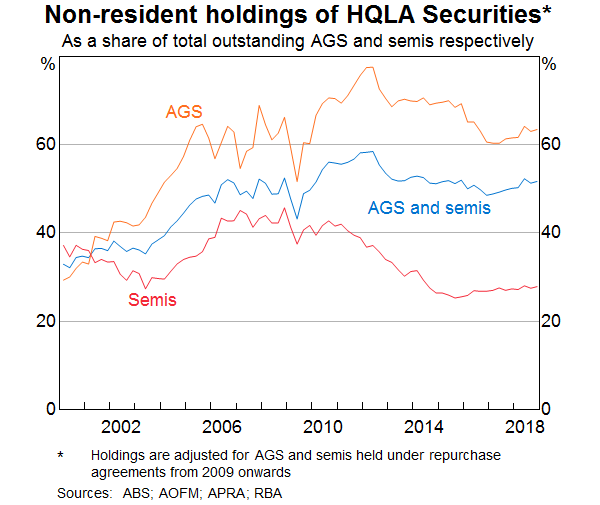
However, over recent years more HQLA securities have become available for use as collateral. In particular, the Australian repo market has grown substantially, driven by more HQLA securities being sold under repo. Of note, non-residents have been lending more of their holdings of AGS and semis back into the domestic market (Graph 5).
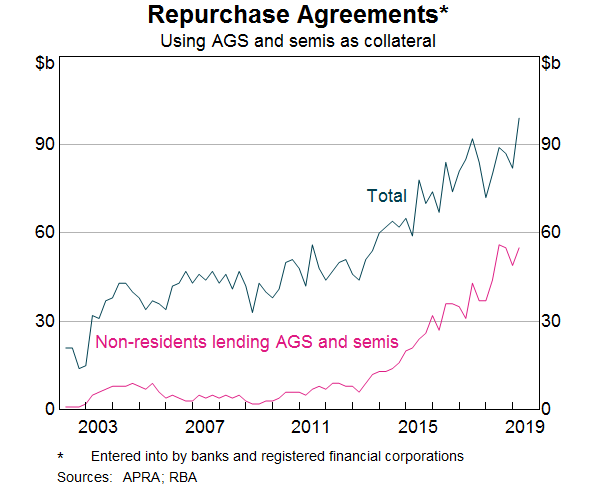
Also, our analysis of transactions in bond and repo markets demonstrates that most HQLA securities were being actively traded. Turnover ratios for individual AGS bond lines were well above zero and much higher than for other Australian dollar securities. Although semis were traded less frequently than AGS, only a small share of the bond lines of semis had low turnover ratios (Graph 6). Given this, it appears unlikely that a moderate increase in banks' holdings of AGS and semis would present a problem for liquidity in these markets.
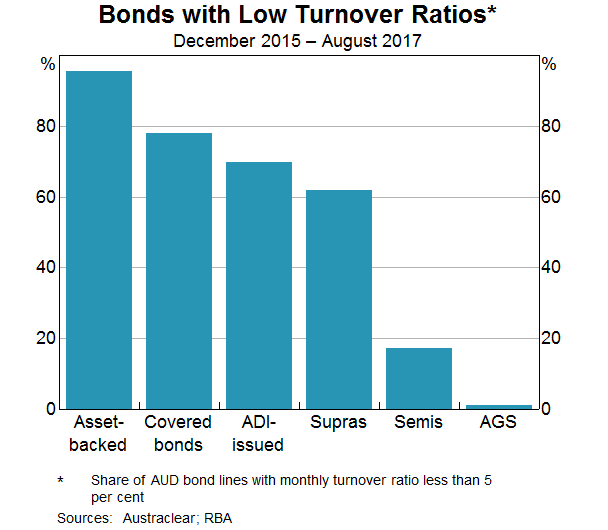
Another issue we considered in 2015 was the ‘scarcity premium’ that was present for AGS. Australia's relatively strong economic performance and AAA credit rating have been very appealing for investors globally. The scarcity premium was prominent in the years leading up to 2015, when the yield on AGS was well below the expected cash rate over the period to maturity (Graph 7). Since then, however, the scarcity premium has gradually dissipated. This has occurred alongside an increase in the stock of AGS. It is also consistent with these securities being less tightly held. The combination of these changes suggests that the banks can now hold a higher share of the AGS on issue without impairing the functioning of the market.
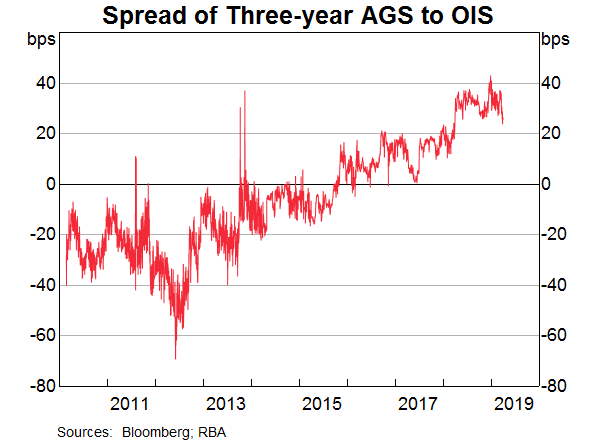
This brings us to the first of two changes that we have made to the settings of the CLF. We have assessed that banks can increase their holdings of HQLA securities from 25 to 30 per cent of the outstanding stock. This will result in the CLF being smaller than it otherwise would have been. To minimise the effect of this change on the market, the increase will occur at the gradual pace of 1 percentage point each year, beginning with an increase to 26 per cent in 2020.
Setting the CLF Fee
The second change we are implementing relates to the CLF fee.
The CLF fee should be set at a level at which banks will face similar financial incentives to meet their LCR through the CLF or by holding HQLA (if there were enough available). However, determining this level of the fee is easier to do in theory than in practice.
The starting point for determining the fee is to make use of the spread between the yields on HQLA securities and the collateral that the banks hold for the CLF. This collateral is all eligible for the RBA's market operations, and is mainly the banks' self-securitised residential mortgage backed securities. We have estimated that this spread was around 90 basis points earlier this year. But the higher yield on CLF collateral reflects compensation for a variety of risks. In particular, a sizeable share of the spread owes to the higher credit risk on these securities. However, the CLF fee should only reflect the liquidity risk component of the spread, and that is very difficult to identify separately.[6]
When the Reserve Bank set the CLF fee earlier this decade, it looked at repo rates on some CLF-eligible securities to gauge how much a one-month liquidity premium might be worth. The answer was not very much in normal circumstances. Based on data from the RBA's open market operations, it was estimated to be around 10 basis points. However, given that part of the point of the liquidity reforms was to recognise that the market had underpriced liquidity in the past, it was judged to have been appropriate to set the fee at 15 basis points.
Now that we have several years of experience with the CLF, we can look back and see how the banks have responded to the existing framework. Since the CLF was introduced, the banks, in total, have consistently overestimated their ‘net cash outflow’ projections in their CLF applications for the following year.[7] These projections were used by APRA to determine the size of the CLF. As a result, the banks have been granted a larger CLF than would have been the case had the net cash outflow projections been more accurate ex ante (Graph 8). In recent years, the banks have also been holding fewer HQLA securities than the RBA judged that they could reasonably hold. Taken together, these observations suggest that the CLF fee should be set at a higher rate in the future.
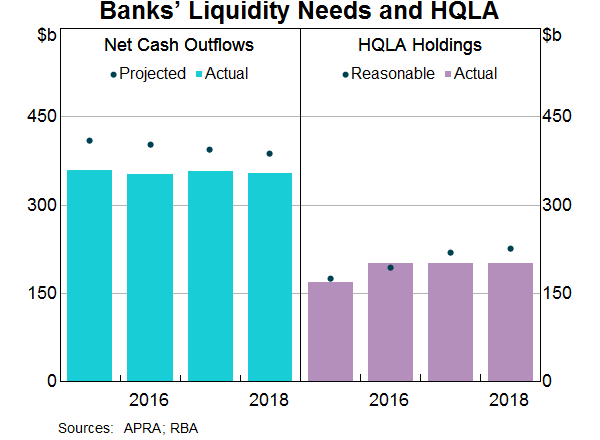
A higher CLF fee will help to make the banks indifferent between holding more HQLA securities and asking for a larger CLF. However, if the fee is too high, this could trigger a disruptive shift away from using the CLF facility and create distortions in the markets that use HQLA. Accordingly, we have concluded that the fee should be increased moderately and occur in two steps. The fee will rise from 15 to 17 basis points in January 2020 and to 20 basis points in January 2021.
When taken together, these two changes to the settings for the CLF will result in a small increase in the cost of the CLF for the banks. To show this, we can fully apply the new settings to the current CLF amounts, assuming everything else is held constant. If the banks were holding the higher level of AGS and semis that the RBA has assessed would be reasonable, this would reduce the size of the CLF from just below $250 billion to around $200 billion. If we then apply the 5 basis points total increase in the CLF fee, collectively the banks would pay around $30 million more than they do currently for the liquidity commitment they receive from the RBA.[8]
Conclusion
In conclusion, the CLF is important for Australia's implementation of the Basel III liquidity reforms. The facility has been working well, but after five years it is time to make some modest and gradual adjustments to the settings, in a way that reduces the need of the banks to make use of the CLF while also increasing their cost of doing so a little. In combination, these changes will help to ensure that the banks continue to have strong incentives to manage their liquidity risk appropriately.
Endnotes
I thank Michelle Bergmann, Ellis Connolly, Joseph Muscatello and Dmitry Titkov for invaluable assistance in preparing these remarks. [*]
See RBA (Reserve Bank of Australia) (2019), ‘Reserve Bank Adjusts the Committed Liquidity Facility’, Media Release No 2019-16, 7 June. [1]
Bergmann M, E Connolly and J Muscatello (2019), ‘The Committed Liquidity Facility’, RBA Bulletin, September, viewed 23 July 2019. [2]
The other approaches include the regulator allowing banks to hold foreign currency HQLA to cover domestic currency liquidity needs, or allowing banks to hold lower quality assets as HQLA (known as Level 2 assets), with haircuts applied. [3]
For more information about the introduction of the CLF, see Debelle G (2011), ‘The Committed Liquidity Facility’, Speech to the APRA Basel III Implementation Workshop 2011, Sydney, 23 November. [4]
Banks (more formally, domestically incorporated authorised deposit-taking institutions (ADIs) subject to the LCR) must apply to APRA to obtain approval to establish a CLF. The legal documentation for the CLF is published on the RBA's website at <https://www.rba.gov.au/mkt-operations/resources/tech-notes/pdf/clf-terms-and-conditions.pdf> and <https://www.rba.gov.au/mkt-operations/resources/tech-notes/clf-operational-notes.html>. [5]
Were a bank to draw on the CLF by selling securities to the RBA under repo, the RBA would only be exposed to credit risk from the securities if the bank defaulted on its obligation to repurchase the securities. To minimise this risk, the RBA imposes haircuts on the securities that it purchases under repo. [6]
This is relative to the banks' final estimates of net cash outflows under the LCR stress scenario using data on their balance sheet position as at the end of the relevant year. [7]
This compares to the CLF banks' annual operating income of around $100 billion. [8]